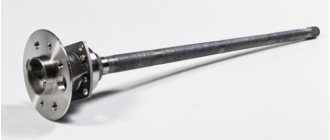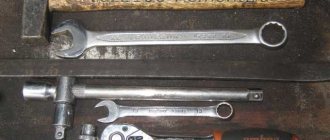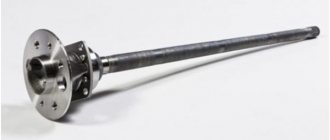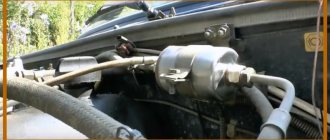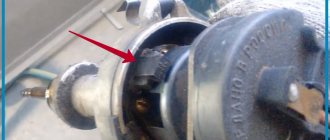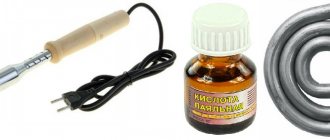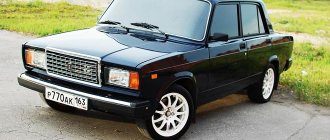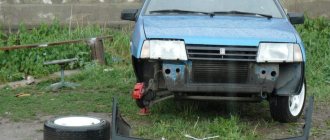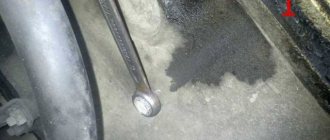Preparation and disassembly
To independently remove a leaking rear axle oil seal on a Niva Chevrolet, you will need the following tools:
- standard set of wrenches;
- slotted screwdriver and wheel wrench;
- jack;
- hammer;
- wooden stand;
- cloth gloves.
Never neglect gloves when repairing a car: they will protect your hands from damage due to accidental impacts. The height of the wooden stand should be enough to support the rear axle with the wheel removed and the shock absorber unscrewed, otherwise oil will leak from it.
Before removing the old seal, you will have to disassemble the rear hub assembly and remove the axle shaft. Disassembly is carried out in the following sequence:
- Place the car on a level surface and secure it with wheel chocks. Make sure the handbrake is turned off.
- Loosen the wheel nuts, jack up the car and remove the wheel.
- Clean the rear axle flange that protrudes beyond the brake drum from rust. Additionally, you can treat this area with WD-40 lubricant.
- Unscrew the 2 bolts securing the drum with a 12 mm wrench, then gently tap with a hammer to move it out of place.
- The drum is removed in 2 ways: by squeezing it out with the same bolts, screwed into other holes, or by knocking it with a hammer through a piece of wood. The methods can be combined, just be careful not to damage the edge of the drum with the blows.
- After dismantling, clean the seat on the axle shaft again to make the drum easier to remove.
The next step is unscrewing and removing the axle shaft. In the VAZ 2131 Niva Chevrolet, 4 bolts securing it are held on the other side by a bracket holding the shock absorber.
After unscrewing the bolts, the shock absorber will no longer hold the rear axle, and the spring will push it down, causing oil to flow.
To avoid this, you need to first adjust the stand by jacking the car higher. The rear axle “stocking” must rest with a slope in the other direction so that the oil does not leak out.
Since in a regular Niva VAZ 21214 and 21213 the shock absorber is attached to the spring cup, and not to the rear hub, there is no need to unscrew it. A stand is also not needed here; a jack is enough to lift it.
The 4 bolts holding the rear axle shaft are unscrewed with a 17 mm wrench
Pay attention to the growers: they should not get lost in the brake mechanism. If you ignore the loss of the groover and install a new one, then the old one will subsequently get between the block and the drum while driving and the wheel will jam. After unscrewing the bolts, remove the axle shaft with the bearing from the cage with a sharp movement
If this fails, attach the wheel to the studs with 3 nuts and try to pull it. The last option is to use a special inertial puller for removal. There is also a popular method: tie the axle shaft with a rope to an iron garage door and hit it with a hammer to knock it out of the cage. But for this you need to carefully park the car closer to the gate
After unscrewing the bolts, with a sharp movement, remove the axle shaft with the bearing from the cage. If this fails, attach the wheel to the studs with 3 nuts and try to pull it. The last option is to use a special inertial puller for removal. There is also a popular method: tie the axle shaft with a rope to an iron garage door and hit it with a hammer to knock it out of the cage. But for this you need to carefully park the car closer to the gate.
Replacing the rear axle shaft: removal and installation
Replacing a bearing on a VAZ 2107 axle shaft
It is necessary to remove the axle shaft on VAZ 2106 vehicles in exceptional cases, and the main ones can be cited:
- Bearing replacement
- Installation of a new axle shaft (due to bending during an accident, for example)
- Replacing the rear axle gearbox
Today I will try to show the order of dismantling and installation with a video and photo report. First of all, it’s worth talking about the tool that we need to solve this problem:
- 17 and 19 mm heads
- Ratchet handle and crank
- Extension
- Hammer
- 7 mm deep head with small ratchet
- Penetrating lubricant
So, first I would like to provide a video instruction for this repair, and only then make a detailed photo report of the work done in case the video is suddenly unavailable.
Video on replacing the rear axle shaft on a VAZ 2106
I think that the following guide will clearly show you how to proceed when performing this procedure.
If you are used to text information, then everything will be shown below in more detail.
Photo report on the removal and installation of the rear axle shaft on a VAZ 2106
So, the first thing you need to do is remove the rear wheel mounting bolts, jack up the car and finally unscrew the bolts and remove the wheel. After this, it is necessary to remove the brake drum, since it is under it that all the axle shaft mounting nuts are located. As a result, we get the following picture:
Next, you need to align the holes in the axle flange with the fastening nuts. Since there are two such holes, you need to do this twice, of course, then turn the axle shaft so that the third and fourth fastening nuts are accessible in the holes.
It is advisable to first apply a penetrating lubricant and then rip it off with a wrench:
When the force is already small, you can use a ratchet handle for greater convenience:
When all 4 are completely unscrewed, you can then begin to remove the axle shaft. To do this, take the wheel, turn it over and screw it onto two bolts, just tighten it so that there is a slight spread across the bolts. This is clearly shown in the photo below:
And with sharp jerks using both hands we try to pull the axle shaft off the splines. This usually happens after the first jerk, since it does not require much effort:
Next, you can unscrew these bolts and remove the wheel, and finally remove the axle by hand:
After this, you can replace either the axle shaft itself or its bearing if necessary (I’ll write about this in future articles). Installation takes place in reverse order and does not take much time. The only thing worth noting is that when installing it is necessary to ensure that it matches the slots and hit it with a small blow. But I think that everything is clear from the video clip. As for the price of a new axle shaft for a VAZ 2106, it can range from 100 to 1300 rubles.
vaz2106-remont.ru
Important points
You need to be very careful when cutting off the old bearing with a grinder so as not to touch the axle shaft itself. It is best to cut off only the outer ring of the bearing and the cage with a grinder. Only a few small cuts should be made on the inner ring (not through)
Then you can insert a chisel into these cuts and, with a few careful and precise blows, split the inner ring of the bearing without touching the axle shaft. The inner ring of the bearing is cut off with a chisel
Only a few small cuts (not through) should be made on the inner ring. Then you can insert a chisel into these cuts and, with a few careful and precise blows, split the inner ring of the bearing without touching the axle shaft. The inner ring of the bearing is cut off with a chisel
The new bearing cannot be placed on the axle shaft without effort. In fact, it will have to be stuffed onto the axle. But in no case should you use only a hammer for this, since there is a high risk of distortion and damage. The best way is to take a piece of pipe whose diameter is slightly larger than the diameter of the axle shaft, and use it to seat the part in place. Some car enthusiasts heat the bearings and place them hot on the axle shaft. This really makes it easier to fit the new part because all the metals expand when heated. But it is strictly forbidden to install bearings in this way, since when this part is heated and subsequently cooled in air, it may anneal (that is, heat treatment, which consists of heating the steel to temperatures below critical, followed by slow cooling). Annealing will reduce the hardness of the bearing several times and increase its ductility, as a result, its service life will be reduced significantly.
This is interesting: Roads in the Moscow region will be equipped with special vibration strips
Replacing a bearing is a difficult task, but it can be done. The main thing here is to avoid damage to the axle shaft when cutting off the bearing and distortions when installing a new part
In addition, you should take into account the fragility of the bearing rings and use the hammer with extreme caution. Otherwise, the procedure is quite within the capabilities of even a novice car enthusiast, who, by doing it with his own hands, can save a significant amount. Copywriter with five years of experience
(1 vote, average: 1 out of 5)
Copywriter with five years of experience. (1 vote, average: 1 out of 5)
Malfunctions of VAZ 2107 axle shafts, their causes and symptoms
The main failures of axle shafts include:
- shaft deformation;
- fracture;
- wear or cutting of splines;
- Damage to the wheel rim mounting threads.
Deformation
The axle shaft, although made of high-strength steel, can become deformed under high loads. Such a malfunction is often a consequence of gearbox jamming, bearing problems, or the corresponding wheel falling into a deep pothole. A sign of deformation of the axle shaft is strong vibration of the wheel rim, sometimes accompanied by a hum, knocking, or crackling noise.
Fracture
The result of a wheel hitting a pothole or a strong impact on a bump can be a fracture of the axle shaft. In this case, the car loses control because one of the drive wheels stops rotating. If the axle shaft is broken, the gears of the gearbox may also fail, so if such a malfunction occurs, it must be checked.
Worn or cut splines
Natural wear of the axle shaft splines may appear after 200–300 thousand kilometers. More often they are cut off, which occurs when one of the wheels jams and the gearbox malfunctions. Also, the splines are cut off due to wear of the axle gear teeth that mesh with them.
A sign of spline damage is a crunching noise from the gearbox.
A sign of wear or cutting of the splines is a crunch (crack) from the axle shaft, which usually occurs when starting or moving downhill. The crunching sound indicates that the gear teeth are slipping between the axle shaft splines.
Damage to wheel threads
It is quite difficult to damage the threads on the flange, but such troubles still happen. The reason for this may be non-compliance with the tightening torque of the wheel bolts, incorrectly set direction of the bolts when tightening, or violation of the thread pitch on the bolts. A sign of thread damage is vertical play in the wheel, or beating in the rear of the car while driving.
If the listed malfunctions are detected, the axle shaft (one or both) must be replaced. Continuing to drive a vehicle with faulty axle shafts is extremely dangerous.
What are VAZ 2107 axle shafts and how to replace them
In rear-wheel drive cars, which the “seven” actually belongs to, the rear wheels are driving. It is they, rotating, that make the car move. The torque is transmitted to them from the gearbox through the drive (cardan) shaft, gearbox and axle shafts. There are only two axle shafts: one for each rear wheel.
Their role is to transmit torque from the corresponding gear of the gearbox to the wheel rim.
Each of the axle shafts is installed in the corresponding (left or right) rear axle housing. An oil deflector with a gasket and an oil seal are used to prevent lubricant from leaking out of the casing. The bearing is designed to ensure uniform rotation of the axle shaft and distribute shock loads coming from the wheel to the rear axle of the vehicle.
Axle shaft design
The axle shaft is an all-metal shaft made of steel. At one end there is a flange for attaching the wheel disk, and at the other there are splines for engagement with the gearbox gear. If we consider the axle shaft assembly, then in addition to the shaft, its design also includes:
- retaining ring;
- oil seal (cuff);
- bearing.
The VAZ 2107 axle shaft must be replaced in the following cases:
- The axle shafts are replaced if the threads on them are damaged (see photo on the right): the bolts that secure the wheel cannot be tightened and are twisted. The other end of the axle shaft is inserted into the rear axle gearbox (see photo on the left), at the other end there are splines (they are indicated by an arrow), if they come together, the axle shaft will stop rotating altogether, since it will not engage with the gears. Then one wheel will stand still and the other will spin.
- There is another case in which the axle shaft must be replaced - this is wear of the bearing or peeling off of the retaining ring. If the ring has come off its seat, then the rear wheel will have play (by swinging it is easy to understand whether there is this play or not). If there is a problem with the bearing, then noise will appear at one of the rear wheels (play may also be present).
Axle shaft diagnostics
When the axle shaft is removed, you need to check whether it needs to be replaced.
The first step is to check the threads and splined part on the axle shaft. If the threads are not broken and the spline part is intact, move on to the bearing and the retaining ring. First, the bearing: it should sit well, grab it with your hand and move it left and right, it should not move (let's say an axial clearance of 0.7 mm). Next, rotate the bearing: its upper part should rotate, while the middle part should stand firmly on the shaft and not move. Otherwise, the bearing is faulty and requires replacement.
Now the retaining ring, thanks to it, keeps the bearing in its seat and does not move out (if the bearing moves out, the axle shaft will simply fly out of the gearbox), the retaining ring does not perform any other functions. You can tell by eye that the retaining ring has slipped by shaking the bearing, as we said earlier, you can determine one hundred percent whether the retaining ring is seated properly. Sometimes it happens that the axle shaft cracks or bends in some place (usually in the middle part), in this case the axle shaft must be completely replaced!
Removing the axle shaft
To dismantle the axle shaft, you should:
Place the car on a flat surface and place chocks under the front wheels. Use a wheel wrench to unscrew the wheel bolts. Raise the car body with a jack. Unscrew the wheel bolts and remove the wheel. Using a size 8 wrench, unscrew the drum guide pins. Remove the drum
If it does not come off the blocks, carefully knock it down using a spacer and a hammer. If the drum does not give in, it needs to be knocked down using a hammer and a spacer. Using a 17 wrench (preferably a socket one), unscrew the nuts (4 pcs) securing the axle shaft
They are located behind the flange, but you can access them through specially provided holes by turning the axle shaft.
How to remove a broken axle shaft
If the axle shaft is broken, it will not be possible to dismantle it in the usual way. But there are other methods. If the shaft breaks directly in front of the flange and its broken end sticks out of the bridge casing, you can weld a piece of reinforcement to it, and then use it to pull out the rest of the axle shaft.
If the axle shaft breaks inside the casing, you can try to knock it out with a piece of reinforcement inserted from the back side of the bridge, after first removing the opposite axle shaft. In extreme cases, to remove a piece of shaft, you will have to disassemble the gearbox.
Steering gear oil seals
The steering mechanism has two oil seals. One is installed on the bipod shaft, and the second cuff is on the steering gear shaft.
Oil seal (cuff) of the steering gear bipod shaft
Name of the steering gear bipod shaft oil seal:
- According to VAZ classification - 2101-3401023;
- According to GOST - 40000800.
Dimensions of the VAZ 2107 steering gear bipod shaft oil seal:
- Outer diameter - 43 mm;
- Inner diameter - 28.6 mm;
- Thickness - 10 mm.
Why might oil leak?
First, let's try to understand how to determine the time to replace the oil seal. If you believe the manufacturers, a high-quality cuff should last more than 60-70 thousand kilometers. But is this really so? Of course not. Under conditions of constant load, bad roads, dirt falling on parts, and poor quality oil, the oil seal cannot withstand and needs to be replaced quickly. A visual inspection of the rear axle will help identify the need for replacement. It is clear that for a better inspection it is recommended to put the car in a pit. It is often possible to eliminate a leak from the gearbox by tightening loose fastening bolts or replacing the washers with softer options. In this case, copper washers are considered ideal. Often, instead of a washer, a sealant in the form of a thread or ordinary gel is used on threaded connections.
Sealant for threaded connections
In addition, the cause of an oil leak may be an insufficiently tightened drain or filler plug.
Careful attention should also be paid to this. If everything is in order with the plugs, then it would be a good idea to pay attention to the connection of the gearbox to the crankcase
Connection of the gearbox to the crankcase
If the tightness of this connection is broken, then oil leakage cannot be avoided. In this case, replacing the oil seal on the VAZ 2106 bridge or replacing the axle shaft seal will help. As a rule, any leaking oil seal needs urgent replacement. No other type of repair will help here. Oil seals are inexpensive and it is better to replace them periodically so that no problems arise in the future. It also happens that the cause of the leak is the breather. It is located on the upper side of the car crankcase, on the right side.
Breather cover VAZ 2106
First of all, we check the breather cap to see how freely it moves. If everything is fine with it, then it’s all about the oil seal, which requires replacement. Needless to say, if you delay replacement, the oil level will drop and ultimately lead to tragic consequences. As you know, oil for all parts and components of a car is comparable to the oxygen that a person breathes.
Replacing axle seals on a VAZ 2106
A common reason why the oil seal fails is an increased oil level. Therefore, you must always monitor this and not allow it to increase or decrease.
Bridge gearbox. Maintenance and repair
The reliability and service life of the central gearbox of the drive axle directly depends on the quality of its maintenance and repair.
Radial clearance adjustment
Periodic adjustment of the rear axle gearbox helps prevent increased wear of the teeth and promotes their uniform grinding. Increased radial clearance causes wear on the teeth and bearings of the drive gear shaft, and is adjusted using special washers placed under the front flange of the gearbox housing.
It is characteristic that adjusting the VAZ rear axle gearbox is no different from a similar operation for trucks. So, for example, the gearbox of the middle axle of a KAMAZ or MAZ is no different from the design of the rear axle gearbox and has interchangeable parts (except for the housing).
Lubricants
Adjustment, adjustment, but don’t forget about the working fluid, which is used to lubricate the working units of the axle gearbox.
The most widely used lubricants: domestic - TAD-17 or Nigrol, international classification - API (GL-1 - GL-5) or SAE (75 - 250). The increased viscosity that they retain at both low and high temperatures allows them to be used to compensate for fairly high loads that arise during torque conversion (up to 300 kg/mm2).
For optimal operation of the hypoid gear, it is necessary to maintain the recommended level of working fluid, since its decrease leads to premature wear of the teeth of the main pair. However, do not forget that exceeding it can cause harm; in a situation with a VAZ, squeeze out the rear axle gearbox oil seal.
Repair work or how to avoid mistakes
Repair of the VAZ rear axle gearbox is carried out in almost every garage cooperative, often without following the basic rules for its assembly and installation.
So, for example, the Niva rear axle gearbox and the Niva front axle gearbox must have the same gear ratio. Violation of this requirement will lead to uneven redistribution of torque, which can lead to the destruction of one of the main pairs. There are many known cases when, when repairing the front axle gearbox, unfortunate craftsmen contributed their own know-how.
The most common case is to replace the 21213 front axle gearbox with a faster VAZ 2107 rear axle gearbox. Take our word for it: doing this is more than unreasonable. Apart from the failure of the front and rear axle gearboxes, you will receive nothing, and the cost of spare parts is unlikely to be reimbursed to you.
But passenger cars and even VAZs are fine, but what will you do if the rear axle gearbox of a BMW or an equally expensive Toyota or Mercedes is damaged? In order not to tempt fate and not test the strength of your car, the best option is to turn to professionals.
Conceptual service is the key to success
Where is the best place to repair an axle gearbox? This question interests all owners of rear-wheel drive cars, and not only. A conceptual service center can provide high-quality maintenance, repair or replacement of the rear axle gearbox.
When repairing a Mercedes rear axle gearbox, professionals will not look at a book, since they know all the tolerances and radial clearances, as they say: “by heart.” Gazelle rear axle gearbox, KAMAZ rear axle gearbox, MAZ rear axle gearbox, UAZ rear axle gearbox, ZIL 130 rear axle gearbox, GAZ 53 rear axle gearbox, and more common: GAZ 3110 rear axle gearbox, as well as VAZ and Niva.
The schematic diagram of the rear axle gearbox is identical for most domestic and foreign cars. Therefore, if the workman knows perfectly what radial clearance, tolerance or contact patch is. And he also has at his disposal professional tools and technical equipment, as well as a drawing of the rear axle gearbox, then adjusting or repairing it will not be difficult for him.
By contacting the conceptual service center, you receive a full range of services, including the opportunity to buy a VAZ rear axle gearbox at a significant discount. Having weighed all the pros and cons, we come to the only correct conclusion: Conceptual service - no problems and high guarantees of the quality of the work performed.
Replacing the VAZ-2107 axle bearing with your own hands step-by-step video instructions
Every owner of so-called classic cars, for example, VAZ-2107, understands perfectly well that the axle shaft is an integral part of the drive axle of the car, and its main element is the car bearing, which sooner or later fails, so it has to be replaced. Since replacing a failed axle bearing in the VAZ-2107 model is quite simple, every car owner can perform such an operation, if, of course, he follows the recommendations from professionals in the process.
What are the signs that indicate a bearing needs replacement?
- when operating the car, a sound will appear from the outside, which intensifies when the car accelerates;
- when starting the engine, the bearing will refuse to rotate or begin to jam;
- a visual inspection reveals deformation of this element.
Sometimes the above problems can be solved by replacing the bearing itself, and in some cases the problem can be solved after replacing the entire axle shaft.
What will be required during the work
Before work, you need to prepare the most necessary tools and new components:
- a bearing of a suitable size, of course, it is best to install an element that has not previously been in use;
- oil seal for the axle shaft and locking sleeve;
- car keys size 10 and 17;
- jack for raising a car;
- hammer, chisel and grinder.
Experts recommend that you first make sure that it is the bearing that has failed, and only then buy all the necessary components. Since after dismantling is completed, it is discovered that the cause of the failure is not the wear of the bearing, but the rear axle shaft, which cannot be repaired, this means that you will have to buy the entire assembly and install it in place of the failed one.
Phased replacement
Experts recommend replacing the rear axle bearing yourself in stages:
- The machine, as mentioned earlier, is installed on a flat surface, and a stopper is placed under the wheels. A jack is used to lift the wheel behind which there is a bearing that requires replacement.
- The pads and brake disc also need to be removed.
- Using a size 17 wrench, tighten the fasteners that secure the axle shaft.
- The worn bearing is removed from the axle shaft. Sometimes it is not possible to remove this element using improvised tools, then a grinder comes to the rescue. Before using the grinder, the axle shaft must be securely fixed, for example, by clamping it in a special vice.
- After removing the worn element, the surface of the axle shaft must be thoroughly cleaned of all kinds of contaminants.
- A locking wheel and a new bearing are put on the axle shaft. This process requires some effort, so many craftsmen use a regular hammer or heat the element on a gas burner. However, experts do not recommend using any of the above methods. If the new part heats up, it will, of course, be much easier to put it on the axle shaft, but in the future, due to a sharp temperature difference, the element can quickly deform, which will lead to a reduction in its service life. Without heating, you can install a new bearing using a regular piece of metal pipe, the diameter of which will be slightly larger than the diameter of the axle shaft.
- Using a screwdriver, it is better to use a flat tool; the oil seal is removed from its seat, since it has also become unusable.
- A new element is installed in place of the worn element; it is convenient to install it in the seat using a size 13 automotive socket head.
- Next, all that remains is to install the axle shaft with the bearing in its original place and assemble the entire automobile assembly in reverse order.
After reading the information provided in this article, everyone will be able to replace a failed rear axle bearing, and if any stage is not completely clear, you can watch a training video at any time by going to the Internet resource.
Sequence of actions when dismantling the axle shaft
Weight of the rear axle gearbox VAZ 2106
To dismantle the axle shaft and get to the bearing, you must perform the following steps in strict sequence:
- For convenience, the vehicle is placed on a flat surface.
- Secure all the wheels of the car with stops or other devices.
- The wheel bolts must be turned with a wheel wrench until they are slightly loosened before removal.
Removing wheels.
- Use a wheel wrench to completely unscrew all the bolts on the wheels.
- Use a jack to raise the car body and secure the lifting with supports.
Removing the brake drum.
- Remove the two drum guides using a 8 or 12 wrench.
- Remove the drum itself. If necessary, assist removal with hammer blows. To avoid deformation, place a wooden stand. An alternative way to remove the brake drum: start the car, put it in third gear, spin the engine to 3 thousand rpm and sharply press the brake. Repeat acceleration and deceleration several times, after which the drum can be easily removed
Unscrewing the axle shaft bolts.
Little by little, without using much effort, turn the axle shaft to get to the nuts. The axle shaft mounting bolts can be unscrewed using a 17mm socket wrench. They are used to loosen and remove 4 fastening nuts, which are closed with a special flange.
Removing the axle shaft.
We turn the removed brake drum over (with the inner side facing us), screw it to the axle shaft with a couple of bolts and sharply pull it towards ourselves, thus pulling out the axle shaft. (Instead of the brake drum, you can use a previously removed wheel)
But if you have a reverse hammer, you can remove the axle shaft with it. The hammer is attached to the axle shaft with wheel bolts. If you sharply place a load in the opposite direction, then due to the appearance of a shock load, the axle shaft begins to move towards the load. Thus, the axle shaft is removed. Then unscrew the hammer from the axle shaft and remove the rubber sealing ring.
Removing the lock bearing from the axle shaft.
The axle shaft is clamped in a vice and a small cut is made using a grinder on the outside of the locking ring.
The clamped locking ring is finally split by alternately striking the cut from the grinder with a hammer or chisel. Thus, the bearing is removed from the axle shaft. The axle shaft is checked after removing the bearing for surface deformations or chips or other damage. If there are any, then the axle shaft will have to be changed.
Installing a new bearing and lock ring on the axle shaft.
- The boot is pulled out of the new bearing.
- The bearing is then lubricated with grease or grease.
- Reinstall the boot.
- Lubricate the axle shaft with grease.
- Place the bearing on the axle shaft so that the boot is turned towards the oil deflector.
- Use a hammer to drive the bearing into the cell. To make it easier, you can use a piece of pipe. Place one end of it against the axle shaft with the bearing, and hit the other end with a hammer.
- The locking ring is heated with a blowtorch until a white coating appears on it.
- Using pliers, place the ring on the axle shaft of the VAZ 2107.
- Install the ring hermetically tightly to the bearing.
- Cool the lock ring by pouring engine oil onto it.
Replacing the axle shaft seal.
The oil seal to be replaced must be pulled out of its cell. To do this, lift its body with a screwdriver and remove the oil seal. The cell under the oil seal is wiped from the accumulation of dirt and dust, and grease is applied. The new oil seal is inserted into the seat with a spring to the beam. Use a special bushing and a hammer to drive the oil seal so that it is pressed tightly.
Installing the axle shaft.
Installation of the axle shaft is carried out in the reverse order from its removal. Put on the rubber sealing ring and bolt the axle shaft. Use small rotational movements to put it in place.
After installing the axle shaft, it is necessary to check it for the formation of gaps. They shouldn't exist. To do this, the wheels are rotated in all directions. If there are no gaps and no extraneous sounds appear during rotation, then the installation of the bearing and axle shaft was done correctly and correctly.
If necessary, replace the bearing on the second axle shaft in the same manner. Also, when carrying out these actions, you can immediately replace the brake pads and check the presence and level of lubricant in the axle housing.
Changing the oil in the rear axle of a VAZ 2106
Often, car enthusiasts who own a vehicle such as the VAZ 2106 ask the same question. They are interested in which oil fluid is best suited for the rear axle of their car. At the same time, they ask - what volume is needed and how to change the oil?
There are different opinions. But experts recommend filling the rear axle gearboxes of this machine with transmission oil, which is marked 80W90. For example, this is Lukoil 80W90 GL. This group of oils also includes TAD-17 80W-90 or the so-called TNK.
When we've sorted out the oil, it's time to answer another question. Perhaps he is one of the most important. Namely, how much oil is required? So, the oil volume is as follows - 1.3 liters. At the same time, it is possible to change the oil in the gearbox. True, in this case you will need 1.4 liters.
As for the interval, it is necessary to change the oil fluid after every 30,000 kilometers of the vehicle. If you convert the mileage into a time frame, you get 3 years of operation.
The oil fluid is replaced in accordance with the established procedure:
- First of all, you need to use a lift or inspection hole. You will also need a key for “seventeen” and a hexagon for “twelve”.
- Next, unscrew the drain plug in the bridge and place a special container designed for draining the oil fluid. At the same time, the filler plug is also unscrewed. This is necessary so that the oil fluid flows out faster.
We unscrew the drain and filler bolts. When the oil fluid is drained from the bridge, the drain plug is screwed in and new oil is poured. Here you need to use the filler hole. You will also need a special syringe or other suitable tool.
How to change the oil in the rear gearbox of a VAZ. Video
It would be a good idea to treat all components with washing liquid.
1. Wheel brake drum mounting bolt, 2. Guide pin; 3. Oil deflector of the axle bearing; 4. Brake drum; 5. Cast iron brake drum ring; 6. Rear brake wheel cylinder; 7. Fitting for bleeding the brake drive; 8. Axle bearing; 9. Bearing lock ring; 10. Rear axle beam flange: 11. Axle shaft oil seal; 12. Suspension spring support cup; 13. Rear axle beam; 14. Bracket for attaching the upper suspension rod; 15. Axle guide; 16. Differential bearing nut; 17. Differential box bearing; 18. Differential box bearing cover; 19. Breather; 20. Differential satellite; 21. Main gear driven gear; 22. Left axle shaft; 23. Axle gear; 24. Rear axle gear housing; 25. Drive gear adjusting ring; 26. Bearing spacer; 27. Drive gear bearing; 28. Drive gear oil seal; 29. Oil seal mud deflector; 30. Flange-fork of the cardan joint; 31. Nut; 32. Oil deflector; 33. Main gear drive gear; 34. Axle of satellites; 35. Axle gear support washer; 36. Differential box; 37. Right axle shaft; 38. Brackets for fastening suspension parts; 39. Thrust plate of the axle bearing; 40. Rear brake shield; 41. Rear brake pad; 42. Friction lining: 43. Axle shaft flange; 44. Locking plate; 45. Bearing cover mounting bolt.
Replacing the Chevrolet Niva front axle oil seal.
- First you need to remove one or two drives, depending on where replacement is needed.
- After this you need to remove the locking ring
- Using a hammer, knock out the bearing. If you have problems with removal, you can use WD-40 lubricant
- The cover is removed, the old oil seal is knocked out using a pipe.
- The installation site is lubricated and a new O-ring is installed.
- the unit is reassembled.
Hello! Most Chevy owners service the unpretentious units of this popular car themselves. During intensive use, you often have to change consumables, especially in the chassis. I will tell you about this type of service, such as replacing the front axle oil seal of a NIVA Chevrolet. The replacement operation is carried out when oil leaks from the axle housing. A clogged breather causes lubricant to squeeze out.
If grease drips immediately after stopping (while the gearbox is hot), and then the flow stops, the breather must be cleaned. When it is clogged with dirt, the heated air is not released outside during movement. Under pressure, the working fluid of the gearbox will be squeezed out even through serviceable gaskets and seals.
If the breather is in order, but oil still leaks, you will have to replace damaged cover gaskets or O-rings. There are three of them in the front axle, and they are different:
The oil seal that seals the drive gear axis is located at the rear of the axle, at the location where the front propeller shaft is attached. Oil seals for the right and left drive (inner axle joint).
ATTENTION! The left and right oil seals are not the same; they have a direction of rotation. This must be taken into account when purchasing
The direction of rotation of the wheel when moving forward is indicated by the arrow. If the oil is installed incorrectly, the removable notches will drive the lubricant out.
To understand the device, here is the layout of the front axle:
The oil seal is replaced without removing the front axle. If the work is carried out independently, and it is not possible to use a lift, the car is placed on an inspection hole or overpass. We tighten the hand brake and install supports under the rear wheels. Gearbox and transfer case levers in the “Neutral” position. The front part is lifted with a jack and fixed on stops.
We clean the bridge from dirt and leaks of technical fluids. Unscrew the crankcase drain plug and drain the oil from the gearbox. Screw the plug into place.
- Socket wrenches 13, 17 and 24 Hexagon 12 Mounting blade (mount) Wooden block; Hammer; Flat screwdriver; Universal puller, two or three legs; Retaining ring remover; A piece of pipe according to the diameter of the seals; Flushing fluid (kerosene, Carbcleaner, Vince, Laurel); Brush with stiff bristles; Lint-free rags.
- We disconnect the driveshaft from the gearbox by unscrewing the bolts securing it to the flange.
- We separate the internal CV joint housings from the drive gears.
- Using a dynamometer, we determine the moment at which the drive gear begins to rotate freely. To do this, turn the flange mounting nut until the gear begins to rotate. We fix the magnitude of the moment.
- We tighten the bolts into two adjacent flange holes (for fixation).
- We insert a mounting spade between the bolts, hold the flange from turning and unscrew the fastening nut.
- Remove the washer and flange from the spline joint. If it is impossible to remove it by hand, use a universal puller.
7. Remove the oil seal using a flat-head screwdriver. 8. Rinse and thoroughly wipe the replacement area. 9. Replacement of the front axle drive gear oil seal is carried out only with original Chevrolet spare parts. To facilitate pressing, any grease (litol, grease) is applied to the sealing ring. 10. Press in the ring using a pipe of suitable diameter. 11. Place the flange on the spline connection and put on the washer. 12. Tighten the nut to the torque determined when unscrewing. 13. Fasten the cardan shaft.
- We remove both drives (or the one that requires replacement)
- Remove the retaining ring and spring washer;
- Using a hammer, carefully knock down the bearing. If removal is difficult, treat with a penetrating lubricant, such as WD-40.
- Remove the bearing cap with the old seal.
- Using a pipe, knock the oil seal out of the cover;
- Lubricate the new spare part with any grease and press the o-ring into the cover.
7. We assemble the unit. We fill the gearbox with oil in accordance with the maintenance instructions, do a test drive, and check for oil leaks.
Signs of malfunction on the VAZ 2107
If the bearing itself fails or its seat breaks, the car owner will definitely notice this. We list a number of the main signs of failure of this part:
- While driving, a uniform low hum appears in the area of the rear axle, which over time can turn into a loud creaking or crackling sound. And the faster the car goes, the louder the noise becomes.
- A strong play appears on one of the rear wheels (to check this, just jack up the rear axle of the car and pull the wheel with your hands away from you and towards you).
- Balls fall out of the bearing (this means that the separator in which these balls are located has completely collapsed).
- Finally, the rear axle may simply jam. The drive wheels will stop rotating, and this can happen while driving (which may well cause an accident).
The reason for the destruction of a part can be both metal fatigue, which occurs due to very long cyclic loads on this part, and the quality of domestic roads, driving on which is often associated with impacts and other mechanical damage to the rear axle.
How to remove a broken axle shaft
If the axle shaft is broken, it will not be possible to dismantle it in the usual way. But there are other methods. If the shaft breaks directly in front of the flange and its broken end sticks out of the bridge casing, you can weld a piece of reinforcement to it, and then use it to pull out the rest of the axle shaft.
If the axle shaft breaks inside the casing, you can try to knock it out with a piece of reinforcement inserted from the back side of the bridge, after first removing the opposite axle shaft. In extreme cases, to remove a piece of shaft, you will have to disassemble the gearbox.
Changing the axle shaft seal 2123
Replacing the 2123 drive oil seal changes in a similar way, with some differences, since the VAZ 2123 has a slightly different shock absorber mount to the rear axle:
- You will need to unscrew the 4 bolts securing the right rear drive bearing bracket. Then jack up the axle shaft so that its end is slightly higher than the entrance to the rear axle. Then remove the shock absorber mounting bracket from the bearing mounting plate bolts.
- The NIVA has 5 wheel bolts, so to remove the drive using the “wheel method” you will need to screw it onto three bolts, not two.
Otherwise, the procedure for replacing the axle shaft seal 2123 is no different from the process described above for the axle shaft seal 2101, perhaps with the difference that the “NIVA” and “Chevrolet NIVA” are a little higher, which means it will be a little more convenient to work at the bottom.
